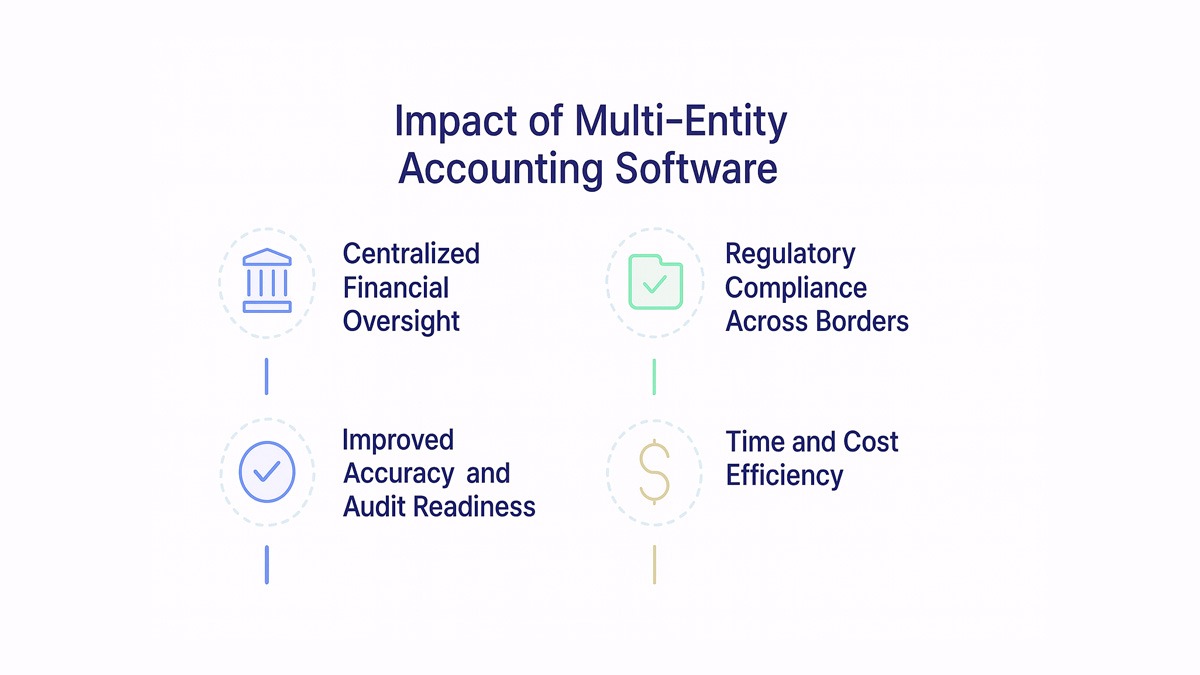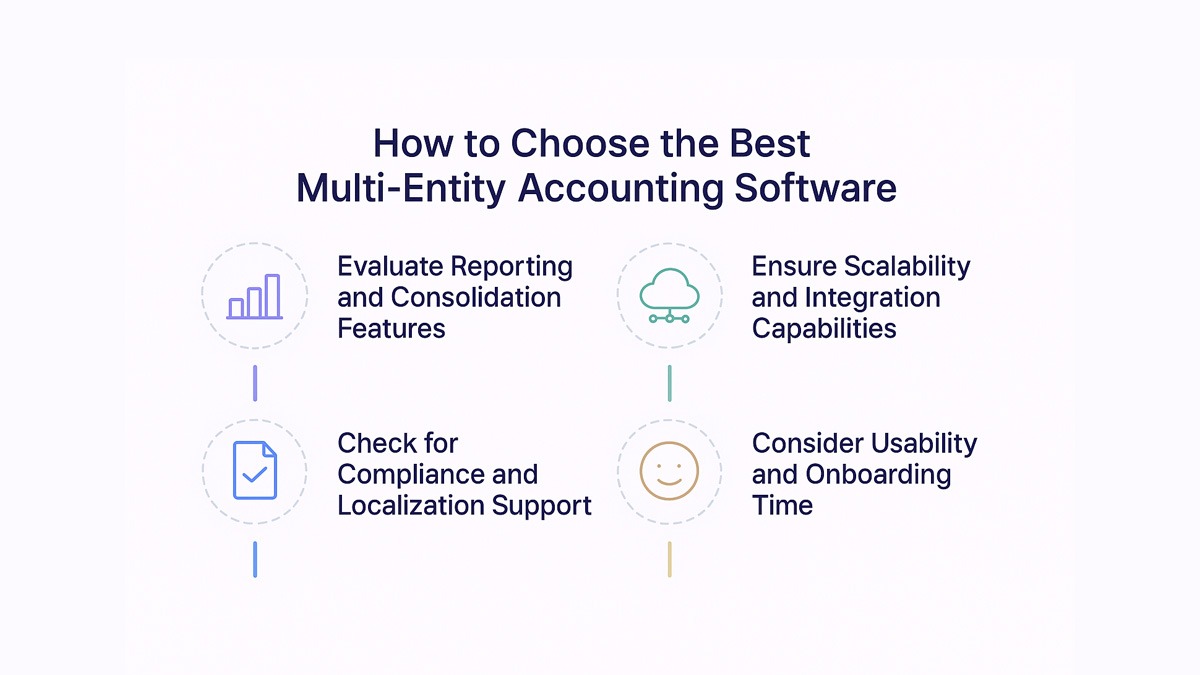

Best Multi-Entity Accounting Software for 2025: A CFO’s Secret to Simplified Finances

Best Multi-Entity Accounting Software for 2025: A CFO’s Secret to Simplified Finances
Compare the best multi-entity accounting tools for 2025 to simplify consolidation, reporting, and compliance across global business entities.


Managing multiple entities under one organization can feel like trying to juggle while walking a tightrope. Each subsidiary has its own set of books, regulations, and currencies - yet the board expects a single, clean financial picture at month-end. Multi-entity accounting software bridges that gap. It brings all those moving parts together, helping finance leaders maintain control, ensure compliance, and close books faster.
What this blog covers:
- What is multi-entity accounting software?
- Why multi-entity accounting software is essential for growing businesses
- Top rated multi-entity accounting & ERP tools
- Tips for choosing the best multi-entity accounting software
- How Spendflo helps with multi-entity SaaS stack optimization
- Frequently asked questions on multi-entity accounting software
What is Multi-Entity Accounting Software?
Multi-entity accounting software enables businesses with multiple subsidiaries or branches to manage all their financial data under one unified system. It automates consolidation, supports multi-currency transactions, and ensures compliance across locations - reducing errors and saving time. In essence, it’s the backbone of financial clarity for organizations operating across borders.
Why Multi-Entity Accounting Software Is Essential for Growing Businesses
As businesses expand, managing finances across entities becomes increasingly complex. Here’s why this software has become indispensable:

Centralized Financial Oversight
Finance teams can view all subsidiary data in one place, eliminating the need for manual consolidation. This unified view allows CFOs to spot trends, forecast accurately, and make informed strategic decisions faster.
Regulatory Compliance Across Borders
Different countries, different rules. Multi-entity platforms help you stay compliant by automating tax, audit, and reporting processes across jurisdictions, ensuring accuracy and peace of mind.
Improved Accuracy and Audit Readiness
Manual data entry often leads to discrepancies. By automating intercompany transactions and eliminating duplicate entries, these systems ensure cleaner books and smoother audits.
Time and Cost Efficiency
Automated consolidation reduces closing time from weeks to days. This eliminates manual bookkeeping tasks that often slow down month-end reporting. The reduced workload on accountants also means fewer resources spent on repetitive, low-value tasks - freeing teams to focus on analysis and growth.
Top Rated Multi-Entity Accounting & ERP Tools
Choosing the right software can make or break your finance operations. Below are some of the best tools that stand out in 2025:
QuickBooks Enterprise
QuickBooks Enterprise remains a favorite for small to mid-sized businesses managing multiple entities. Its strong consolidation features, multi-currency support, and seamless integration with other QuickBooks products make it an accessible choice. Users appreciate its intuitive interface and customizable reporting dashboards that simplify multi-entity accounting without heavy IT support.
NetSuite by Oracle
A powerhouse in the ERP space, NetSuite offers end-to-end functionality - from financial management to procurement and CRM. Its real-time global consolidation feature allows businesses to manage subsidiaries with ease, even across different currencies and tax regulations. Ideal for scaling companies, NetSuite’s automation reduces manual intervention while offering deep analytics for strategic decision-making. Oracle NetSuite continues to lead among enterprise-level multi-entity solutions.
Microsoft Dynamics 365 Business Central
This cloud-based ERP system is perfect for companies already using Microsoft products. Cloud-based accounting software allows teams to access data from anywhere. Its strength lies in integration - linking accounting, sales, inventory, and HR data into a single ecosystem. Features like inventory tracking give a full view of business operations. Multi-entity support allows for consolidated financial statements and automated intercompany transactions, all within a familiar Microsoft environment. Integration with payment gateways also simplifies payment processing across regions.
Sage Intacct
Sage Intacct is designed for finance professionals who crave precision and control. It’s built with powerful consolidation capabilities, allowing automatic currency conversions, eliminations, and audit trails. Advanced systems also improve cash flow forecasting by consolidating trends across global operations. The software’s strength lies in its financial reporting and compliance automation - ideal for companies managing entities across multiple regions or industries.
Xero with Spotlight Reporting
For startups and small enterprises looking for a lighter, cost-effective option, Xero paired with Spotlight Reporting delivers impressive multi-entity functionality. Zoho Books is a good entry-level alternative for growing businesses. It’s particularly effective for global teams managing real-time data across subsidiaries. The integration provides consolidated dashboards and visual financial insights that make executive reporting effortless.
Each of these tools brings unique strengths - from advanced analytics to easy integrations - but the best fit ultimately depends on the scale, industry, and complexity of your operations.
Tips for Choosing the Best Multi-Entity Accounting Software
Choosing the right multi-entity accounting solution isn’t just about finding the most popular brand - it’s about finding a tool that fits your operational complexity, team workflow. Below are key tips to guide your selection process and ensure long-term value:

Evaluate Reporting and Consolidation Features
A strong multi-entity platform should offer real-time consolidated reporting. It should also support tracking of both accounts payable and accounts receivable across entities. Look for software that can auto-generate financial statements across all entities with minimal manual intervention. The ability to drill down into specific transactions within subsidiaries is essential for transparency and compliance.
Ensure Scalability and Integration Capabilities
As your organization grows, your accounting needs will become more complex. Choose a system that can easily scale - whether you’re adding entities, currencies, or locations. It should also support unified vendor lists for better spend visibility. Also, check how well the software integrates with your existing ERP, CRM, and payroll tools to avoid siloed data. A strong API and integration framework ensures smooth interoperability with your existing stack.
Check for Compliance and Localization Support
Global operations mean juggling different tax codes, accounting standards, and compliance requirements. A robust system will support localization for various geographies and offer built-in audit trails and reporting features that satisfy local and international regulations like GAAP or IFRS.
Consider Usability and Onboarding Time
Powerful features are important, but if the system is difficult to use, adoption will suffer. Opt for software with a clean, intuitive interface and strong onboarding resources. Make sure training and support are readily available to help your teams get up to speed without a steep learning curve. Tools with automated workflows can also reduce bottlenecks in approvals and reporting.
How Spendflo Helps with Multi-Entity SaaS Stack Optimization
Spendflo simplifies multi-entity SaaS management by consolidating spend data across subsidiaries into one transparent dashboard. It provides real-time visibility into contracts, renewals, and software usage, helping finance and procurement teams identify overlaps and negotiate better deals. Automated insights surface inefficiencies and drive smarter vendor negotiations. It also enables CFOs to monitor burn rates across departments in real time. For global organizations, Spendflo ensures consistent procurement standards, so you can manage vendor contracts, budgets, and renewals - all from a single source of truth.
Frequently Asked Questions on Multi-Entity Accounting Software
What features should I look for in multi-entity accounting software?
Look for automated consolidation, multi-currency and multi-tax support, intercompany eliminations, and compliance reporting. Integration with ERP systems and scalability are also crucial.
Can small businesses benefit from multi-entity accounting tools?
Absolutely. Even small businesses with multiple branches or subsidiaries can save time and reduce errors with centralized accounting and automated reporting.
How does multi-entity software support international operations?
It simplifies compliance by automating tax calculations, supports multiple currencies, and consolidates global financial data into unified reports for quick insights.
What challenges can arise during implementation?
Common issues include data migration complexities, integration hurdles, and change management. Proper planning and vendor support can mitigate most of these challenges.
What core accounting features should multi-entity software include?
The best platforms cover everything from accounts payable and receivable to managing your general ledger and chart of accounts. They also streamline financial reports and improve visibility into cash flow and forecasting, helping businesses stay audit-ready and efficient.
How do multi-entity tools ensure data security and compliance?
They offer advanced security measures like automated backups and insights, cloud-based access, and strong tax compliance features. Together, these ensure data safety, accuracy, and trust across global entities.










.png)




.png)










.avif)





